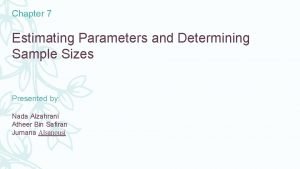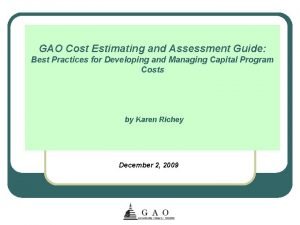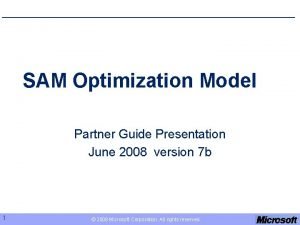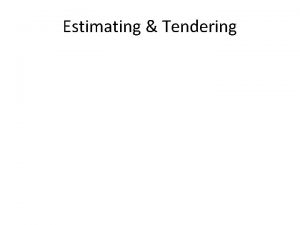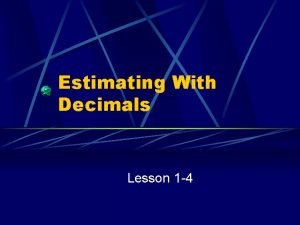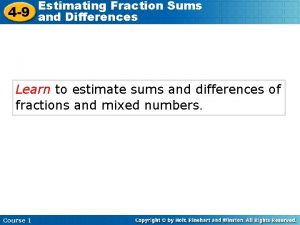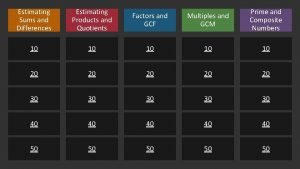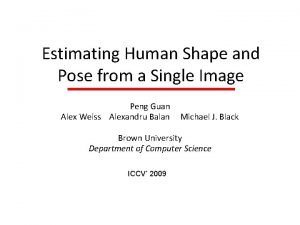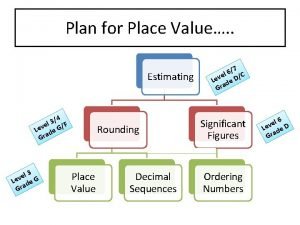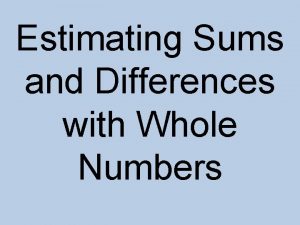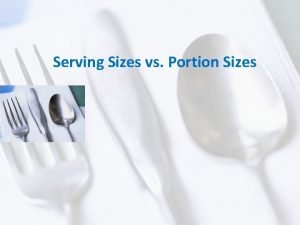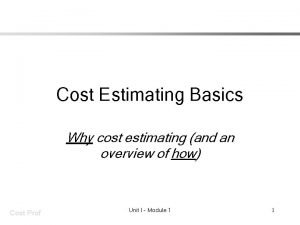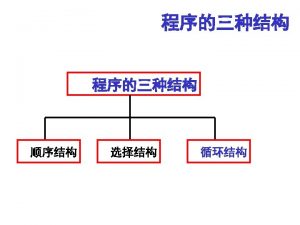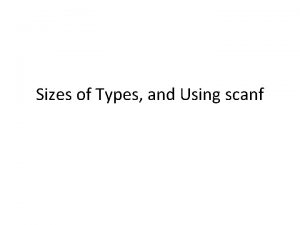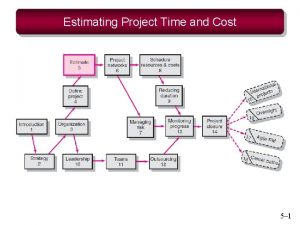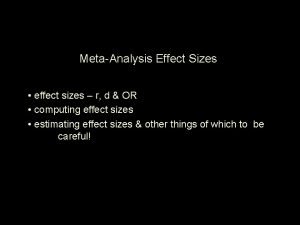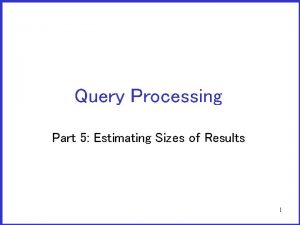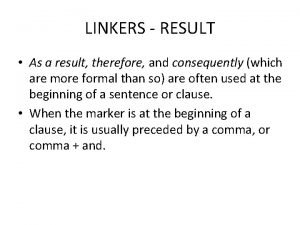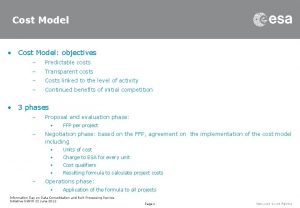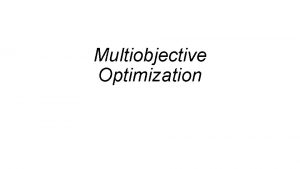Optimization The Cost Model and Estimating Result Sizes




















![Creating an Index • Syntax: create [bitmap] [unique] index iname on table(column [, column]. Creating an Index • Syntax: create [bitmap] [unique] index iname on table(column [, column].](https://slidetodoc.com/presentation_image_h/da07afffd3a4ccbd14ab878567adc73f/image-21.jpg)




























- Slides: 49

Optimization The Cost Model and Estimating Result Sizes

Motivation (1( • We would like to find the cheapest way to calculate the join of three tables: Sailors Reserves Boats

Motivation (2( • We need to decide on the order of operations: (Sailors Reserves) Boats or Sailors (Reserves Boats) • We need to decide which join algorithm to use for each of the operations • What information do we need?

Statistics Maintained by DBMS for Relations • Cardinality NTuples(R): Number of tuples in each relation R • Size NPages(R) : Number of pages in each relation R

Statistics Maintained by DBMS for Indexes • Index Cardinality: Number of distinct key values NKeys(I) for each index I • Index Size: Number of pages INPages(I) in each index I • Index Height: Number of non-leaf levels IHeight(I) in each B+ Tree index I • Index Range: The minimum value ILow(I) and maximum value IHigh(I) for each index I

Note • The statistics are updated periodically (not every time the underlying relations are modified). • We cannot use the cardinality for computing select count(*) from R

Estimating Result Sizes • Consider SELECT attribute-list FROM relation-list WHERE term 1 and. . . and termn • The maximum number of tuples is the product of the cardinalities of the relations in the FROM clause • The WHERE clause is associating a reduction factor with each term. It reflects the impact of the term in reducing result size.

Result Size • Estimated result size: maximum size X the product of the reduction factors

Assumptions • Containment of value sets: if NKeys(I 1)<NKeys(I 2) for attribute Y, then every Y-value of R will be a Y-value of S • Empirically-obtained reduction factor is 1/10 if no additional info is available

Estimating Reduction Factors • column = value: 1/NKeys(I) – There is an index I on column. – This assumes a uniform distribution. – Otherwise, use 1/10. • column 1 = column 2: 1/Max(NKeys(I 1), NKeys(I 2)) – There is an index I 1 on column 1 and an index I 2 on column 2. – Containment of value sets assumption – If only one column has an index, we use it to estimate the value. – Otherwise, use 1/10.

Estimating Reduction Factors • column > value: (High(I)-value)/(High(I)Low(I)) if there is an index I on column.

Example Reserves (sid, agent), Sailors(sid, rating) SELECT * FROM Reserves R, Sailors S WHERE R. sid = S. sid and S. rating > 3 and R. agent = ‘Joe’ • Cardinality(R) = 100, 000 • Cardinality(S) = 40, 000 • NKeys(Index on R. agent) = 100 • High(Index on Rating) = 10, Low = 0

Example (cont(. • Maximum cardinality: 100, 000 * 40, 000 • Reduction factor of R. sid = S. sid: 1/40, 000 – sid is a primary key of S • Reduction factor of S. rating > 3: (10– 3)/(10 -0) = 7/10 • Reduction factor of R. agent = ‘Joe’: 1/100 • Total Estimated size: 700

Database Tuning

Database Tuning • Problem: Make database run efficiently • 80/20 Rule: 80% of the time, the database is running 20% of the queries – find what is taking all the time, and tune these queries

Solutions • Indexing – this can sometimes degrade performance, why? • Tuning queries • Reorganization of tables; perhaps "denormalization" • Changes in physical data storage

Denormalization • Suppose you have tables: – emp(eid, ename, salary, did) – dept(did, budget, address, manager) • Suppose you often ask queries which require finding the manager of an employee. You might consider changing the tables to: – emp(eid, ename, salary, did, manager) – dept(did, budget, address, manager) - in emp, there is a FD did -> manager. It is not 3 NF!

Creating Indexes Using Oracle

Index • Map between – the row key – the row location • Oracle has two kinds of indexes – B* tree – Bitmap • Sorted

B* tree Root 14 2* 3* 5* 7* 14* 16* 19 24 19* 20* 22* 33 24* 27* 29* 33* 34* 38* 39*
![Creating an Index Syntax create bitmap unique index iname on tablecolumn column Creating an Index • Syntax: create [bitmap] [unique] index iname on table(column [, column].](https://slidetodoc.com/presentation_image_h/da07afffd3a4ccbd14ab878567adc73f/image-21.jpg)
Creating an Index • Syntax: create [bitmap] [unique] index iname on table(column [, column]. . . )

Unique Indexes create unique index rating_bit on Sailors(rating); • Create an index that will guarantee the uniqueness of the key. Fail if any duplicate already exists. • When you create a table with a – primary key constraint or – unique constraint a "unique" index is created automatically

Bitmap Indexes • Appropriate for columns that may have very few possible values • For each value c that appears in the column, a vector v of bits is created, with a 1 in v[i] if the i-th row has the value c – Vector length = number of rows • Oracle can automatically convert bitmap entries to Row. IDs during query processing

Bitmap Indexes: Example Sid Sname age rating 12 Jim 55 3 13 John 46 7 14 Jane 46 10 15 Sam 37 3 create bitmap index rating_bit on Sailors(rating); • Corresponding bitmaps: – 3: <1 0 0 1> – 7: <0 1 0 0> – 10: <0 0 1 0>

When to Create an Index • Large tables, on columns that are likely to appear in where clauses as a simple equality • where s. sname = ‘John’ and s. age = 50 • where s. age = r. age

Function-Based Indexes • You can't use an index on sname for the following query: select * from Sailors where UPPER(sname) = 'SAM'; • You can create a function-based index to speed up the query: create index upp_sname on Sailors(UPPER(sname));

Index-Organized Tables • An index organized table keeps its data sorted by the primary key • Rows do not have Row. IDs • They store their data as if they were an index create table Sailors( sid number primary key, sname varchar 2(30), age number, rating number) organization index;

Index-Organized Tables (2( • What advantages does this have? – Primary key is not duplicated in the index – Improve performance of queries based on the primary key • What disadvantages? – expensive to add columns, dynamic data • When to use? – where clause on the primary key – static data

Clustering Tables Together • You can ask Oracle to store several tables with common columns together on the disk • This is useful if you often join these tables • Cluster: area on the disk where the rows of the tables are stored • Cluster key: the columns by which the tables are usually joined in a query

Clustering Tables Together: Syntax • create cluster sailor_reserves (X number); – Create a cluster with nothing in it • create table Sailors( sid number primary key, sname varchar 2(30), age number, rating number) cluster sailor_reserves(sid); – create the table in the cluster

Clustering Tables Together: Syntax (cont(. • create index sailor_reserves_index on cluster sailor_reserves – Create an index on the cluster • create table Reserves( sid number, bid number, day date, primary key(sid, bid, day) ) cluster sailor_reserves(sid); – A second table is added to the cluster

Sailors Reserves sid sname rating age sid bid day 22 Dustin 7 45. 0 22 102 7/7/97 31 Lubber 8 55. 5 22 101 10/10/96 58 Rusty 10 35. 0 58 103 11/12/96 Stored sid sname rating age bid day 22 Dustin 7 102 7/7/97 45. 0 101 10/10/96 31 Lubber 8 55. 5 58 Rusty 10 35. 0 103 11/12/96

The Oracle Optimizer

Types of Optimizers • There are different modes for the optimizer ALTER SESSION SET optimizer_mode = {choose|rule|first_rows(_n)|all_rows} • RULE: Rule-based optimizer (RBO) – deprecated • CHOOSE: Cost-based optimizer (CBO); picks a plan based on statistics (e. g. number of rows in a table, number of distinct keys in an index) – Need to analyze the data in the database using analyze command

Types of Optimizers • ALL_ROWS: execute the query so that all of the rows are returned as quickly as possible – Merge Join has priority over Block Nested Loop Join • FIRST_ROWS(n): execute the query so that all of the first n rows are returned as quickly as possible – Block Nested Loop Join has priority over Merge Join

Analyzing the Data analyze table | index <table_name> | <index_name> compute statistics | estimate statistics [sample <integer> rows | percent] | delete statistics; analyze table Sailors estimate statistics sample 25 percent;

Viewing the Execution Plan (Option 1( • You need a PLAN_TABLE table. So, the first time that you want to see execution plans, run the command: @$ORACLE_HOME/rdbms/admin/utlxplan. sql • Set autotrace on to see all plans – Display the execution path for each query, after being executed

Viewing the Execution Plan (Option 2( explain plan set statement_id=‘<name>’ • Another option: for <statement> explain plan set statement_id='test' for SELECT * FROM Sailors S WHERE sname='Joe'; Select … from Plan_Table where statement_id=‘test’;

Operations that Access Tables • TABLE ACCESS FULL: sequential table scan – Oracle optimizes by reading multiple blocks – Used whenever there is no where clause on a query select * from Sailors • TABLE ACCESS BY ROWID: access rows by their Row. ID values. – How do you get the rowid? From an index! select * from Sailors where sid > 10

Types of Indexes • Unique: each row of the indexed table contains a unique value for the indexed column • Nonunique: the row’s indexed values can repeat

Operations that Use Indexes • INDEX UNIQUE SCAN: Access of an index that is defined to be unique • INDEX RANGE SCAN: Access of an index that is not unique or access of a unique index for a range of values




When are Indexes Used/Not Used? • If you set an indexed column equal to a value, e. g. , sname = 'Jim' • If you specify a range of values for an indexed column, e. g. , sname like 'J%' – sname like '%m': will not use an index – UPPER(sname) like 'J%' : will not use an index – sname is null: will not use an index, since null values are not stored in the index – sname is not null: will not use an index, since every value in the index would have to be accessed

When are Indexes Used? (cont( • 2*age = 20: Index on age will not be used. Index on 2*age will be used. • sname != 'Jim': Index will not be used. • MIN and MAX functions: Index will be used • Equality of a column in a leading column of a multicolumn index. For example, suppose we have a multicolumn index on (sid, bid, day) – sid = 12: Can use the index – bid = 101: Cannot use the index

Optimizer Hints • You can give the optimizer hints about how to perform query evaluation • Hints are written in /*+ */ right after the select • Note: These are only hints. The Oracle optimizer can choose to ignore your hints

Hints • FULL hint: tell the optimizer to perform a TABLE ACCESS FULL operation on the specified table • ROWID hint: tell the optimizer to perform a TABLE ACCESS BY ROWID operation on the specified table • INDEX hint: tells the optimizer to use an indexbased scan on the specified table

Examples Select /*+ FULL (sailors) */ sid From sailors Where sname=‘Joe’; Select /*+ INDEX (sailors s_ind) */ sid From sailors S, reserves R Where S. sid=R. sid AND sname=‘Joe’;
 Common critical values
Common critical values Men's shirt sizes are determined by their neck sizes
Men's shirt sizes are determined by their neck sizes Cost analysis and estimating for engineering and management
Cost analysis and estimating for engineering and management Cost analysis and estimating for engineering and management
Cost analysis and estimating for engineering and management Cost analysis and estimating for engineering and management
Cost analysis and estimating for engineering and management Cost analysis and estimating for engineering and management
Cost analysis and estimating for engineering and management Cost analysis and estimating for engineering and management
Cost analysis and estimating for engineering and management Ground rules earthwork estimating software
Ground rules earthwork estimating software Estimating project time and cost
Estimating project time and cost Estimating project time and cost
Estimating project time and cost Estimating project time and cost
Estimating project time and cost Mii cost estimating
Mii cost estimating Cost accumulation and cost assignment
Cost accumulation and cost assignment Cost accumulation and cost assignment
Cost accumulation and cost assignment Cost accumulation and cost assignment
Cost accumulation and cost assignment Cost accumulation and cost assignment
Cost accumulation and cost assignment Dennis geyer
Dennis geyer What is standard costing
What is standard costing Distinguish between average cost and marginal cost
Distinguish between average cost and marginal cost Cost control and cost reduction difference
Cost control and cost reduction difference Process costing vs job order costing
Process costing vs job order costing Ordering cost and carrying cost
Ordering cost and carrying cost Opportunity cost vs trade off
Opportunity cost vs trade off Cost control and cost reduction project report
Cost control and cost reduction project report Cost control and cost reduction project report
Cost control and cost reduction project report Cost structure refers to the relative proportion of
Cost structure refers to the relative proportion of Sequential model based optimization
Sequential model based optimization Markowitz model of risk return optimization
Markowitz model of risk return optimization Microsoft sam optimization model
Microsoft sam optimization model Sam optimization model
Sam optimization model It infrastructure optimization
It infrastructure optimization Rounding and estimating
Rounding and estimating Anova effect size
Anova effect size Bangus market forms
Bangus market forms Tendering and estimating
Tendering and estimating Define estimation in electrical engineering
Define estimation in electrical engineering Agile estimating and planning
Agile estimating and planning What is front-end estimation with decimals
What is front-end estimation with decimals Estimating decimals
Estimating decimals Estimate fraction sums and differences
Estimate fraction sums and differences 567x7
567x7 Parts of syringe
Parts of syringe Estimating soil moisture by feel and appearance
Estimating soil moisture by feel and appearance Estimating human shape and pose from a single image
Estimating human shape and pose from a single image Place value and estimating
Place value and estimating Estimating sums and differences of whole numbers
Estimating sums and differences of whole numbers Hem sheela model school result
Hem sheela model school result Manufacturing cost vs non manufacturing cost
Manufacturing cost vs non manufacturing cost Job costing and process costing
Job costing and process costing Floatation cost
Floatation cost
